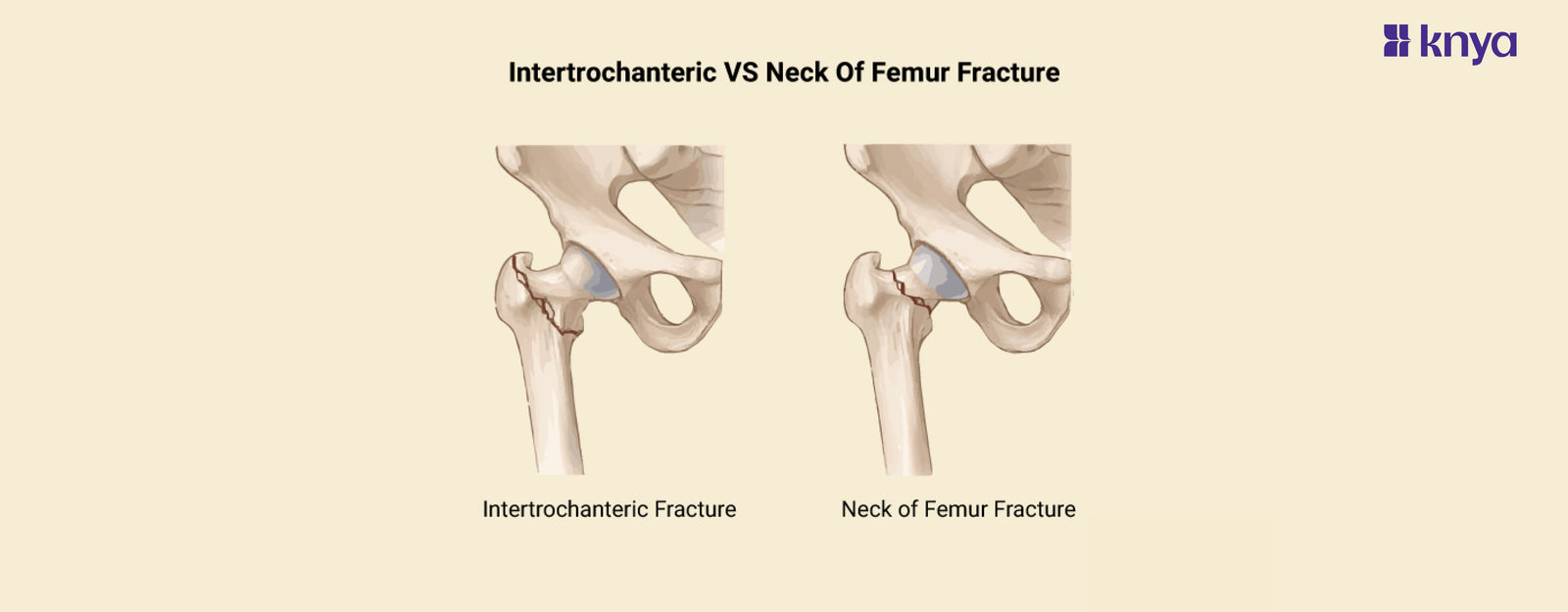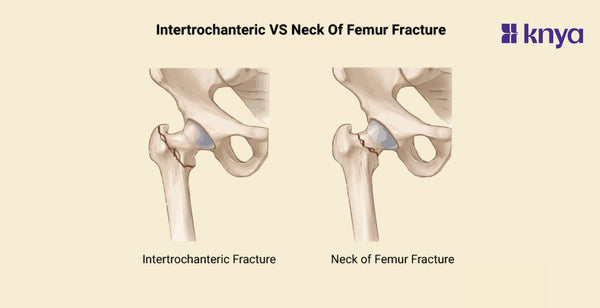Intertrochanteric and neck of femur fractures are both breaks in the upper thigh bone (femur) around the hip joint, although they occur in different places and have distinct effects. Intertrochanteric fractures are more stable due to surrounding muscles and occur directly below the ball of the hip, between two bony bumps called trochanters. Fractures of the neck of the femur, which are closer to the joint, impair blood flow to the bone head, potentially impeding rehabilitation. Both are common in elderly persons as a result of osteoporosis and are frequently caused by falls, resulting in discomfort, limb shortening, and outward rotation. Surgery using screws, pins, or hip replacements is usually followed by physical therapy to recover mobility.
Difference between Intertrochanteric and Neck Of Femur Fracture
Both intertrochanteric and neck of femur fractures are serious injuries affecting the upper part of the thigh bone (femur) but differ in location, stability, and treatment approaches. Listed are the difference between Intertrochanteric and Neck of Femur Fracture:
|
Feature |
Intertrochanteric Fracture |
Neck of Femur Fracture |
|
Location of Fracture |
Between greater and lesser trochanters |
Below the head of the femur |
|
Blood Supply |
Generally better, lower risk of avascular necrosis |
More prone to disruption, higher risk of avascular necrosis |
|
Mechanism of Injury |
High-energy trauma, such as falls or direct impact |
Low-energy trauma, often simple falls |
|
Age Group |
Wider age range, including younger individuals |
More prevalent in the elderly population |
|
Fracture Stability |
Generally more stable due to trochanters |
Can be less stable, higher risk of complications like displacement |
|
Deformity |
Shorter and externally rotated leg |
May lead to more subtle deformity, such as leg shortening |
|
Surgical Approach |
Open reduction and internal fixation (ORIF) |
Various surgical options, including internal fixation or replacement |
|
Complication Risks |
Lower risk of avascular necrosis, higher risk of fixation failure |
Higher risk of avascular necrosis, lower risk of fixation failure |
|
Rehabilitation |
Quicker rehabilitation process |
May require a more prolonged rehabilitation due to potential complications |
|
Prevalence |
More common than neck of femur fractures |
Less common but often associated with more severe consequences |
What is an Intertrochanteric Fracture?
Intertrochanteric fractures occur when the top section of the thigh bone, right behind the hip joint, fractures. They occur at the level of the larger and lesser trochanters, which are bony bumps that anchor numerous muscles. These fractures are most frequent in elderly persons and are generally the consequence of low-impact falls caused by osteoporosis-weakened bones.
Severe hip discomfort, difficulty to bear weight on the affected leg, and the limb seeming shortened and externally rotated are all symptoms. Surgery is usually used to stabilise the fracture with screws, plates, or nails. Physical therapy is critical for healing and mobility.
Key Features of Intertrochanteric Fracture:
- It is located between the greater and lesser trochanters, which are bone bumps on the top section of the femur where muscles connect.
- Variable, with pieces frequently looking jagged and dislocated as a result of many fracture lines.
- Injuries are usually caused by low-energy falls, such as sliding on a rug or tripping on uneven ground.
- Often managed with surgery due to the complex fracture pattern and instability. Options include internal fixation with screws or nails, or joint replacement if the fracture is severe.
What is the neck of a femur fracture?
Neck of Femur fractures occur in the narrow part of the thigh bone just below the ball of the hip joint. They're also common in older adults and often caused by falls. Unlike intertrochanteric fractures, Neck of femur fractures can disrupt blood supply to the femoral head, potentially impacting bone healing.Symptoms are similar to intertrochanteric fractures, with intense hip pain, inability to put weight on the leg, and shortening and external rotation of the leg. Treatment options depend on the fracture type and displacement. Surgery is usually necessary, with procedures like internal fixation or hip replacement being common. Rehabilitation plays a vital role in recovery and regaining function.
Key Features of the Neck of a Femur Fracture:
- Occur in the restricted area linking the femoral head to the shaft, similar to the neck of a bottle.
- Fracture pattern: A single fracture line, straight or angled, that may be displaced or non-displaced.
- Injuries can be caused by falls as well as higher-impact injuries such as vehicle accidents.
- Treatment options include internal fixation with pins or screws or hip replacement surgery, depending on the kind of fracture and patient characteristics.
Shop Best Lab Coats from Here!
Similarities Between Intertrochanteric and neck of femur fractures
- Both fractures are located in the proximal femur.
- Increased Risk in the aged: Both fractures are more prevalent in the aged population, particularly in those who have osteoporosis.
- Falls are a common cause of both types of fractures, but with varying degrees of energy involved.
- Surgical intervention is frequently necessary for both fractures to achieve correct alignment and stability.
- Both types of fractures pose the risk of infection, nonunion, malunion, and deep vein thrombosis.
Both intertrochanteric and neck of femur fractures are common proximal femoral injuries, particularly in the elderly, although there are significant distinctions in their location, stability, treatment, and results. Intertrochanteric fractures include the greater and lesser trochanters and result in a more stable extracapsular break right below the femoral head. Neck of femur fractures, on the other hand, occur within the joint capsule, rendering them intrinsically unstable and possibly jeopardising blood flow to the femoral head. Because of the difference in site, intertrochanteric fractures are frequently amenable to internal fixation, whereas neck of femur fractures may need hip replacement owing to vascular problems. While both fractures provide major obstacles, a good awareness of these anatomical and therapeutic differences serves as the cornerstone for optimum care.















